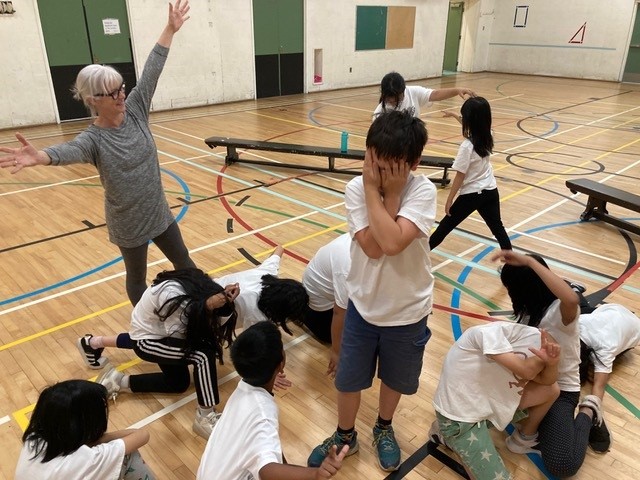In this new blog series, Inside our Community Programs, we interview Arts Umbrella instructors who work in our Donor-Funded Community Programs. For many children, Arts Umbrella is their first experience with the world of art. Our Donor-Funded Community Programs harness Arts Umbrella magic and expertise, bringing free-of-charge, high-quality arts classes to Metro Vancouver’s underserved youth. To learn more about Arts Umbrella’s Community Programs, click here. Enjoy the fifth blog in this series as we interview Creative Dance Instructor, Lorraine White-Wilkinson.
Lorraine (she/her) is Arts Umbrella Dance’s Creative Dance liaison. She has been instructing Early Learning programs at Arts Umbrella for 10 years, though her involvement began 18 years ago when her daughter was a student in the Dance program. As an Arts Umbrella parent, Lorraine worked both as a volunteer and then as a Costume Coordinator for Dance. In her current role with Community Programs, Lorraine instructs in the yearlong after-school Creative Dance program at Cunningham Elementary, which runs once per week. She also instructs in the Head Start program for ages 3-5 at two daycare centres: Mount Pleasant Neighbourhood House and Grandview Terrace Childcare.
What does a Community Program Dance class tend to look like?
“Well, the students have been in school from 9 AM until 3 PM and so they have a snack break first, and then after snack, we play some dance and movement games as they have been sitting all day and have a lot of energy to let out. I then introduce a more formal dance warm-up with exercises that include counts, stretch and strength, and coordination before doing some across-the-floor work. I am the leader, but I am also the follower. The intent is for the students to feel empowered, seen, and heard. In dance, for me, it’s an outlet where we co-create the experience. Often my goals for the day don’t happen but that doesn’t matter. What matters is that the students are engaged, they feel valued, and each individual feels that they are an important part of the group and this is all experienced through dance.”
What has been a standout successful experience for one of your students?
“Last year I had a student who emotionally was in a very different place to the other students. At the beginning of the year, they were angry, they didn’t want to participate, and if they didn’t get things correct right away, they would quit. The Youth and Family Worker who works at the school chatted with them and got them back on track, and by the end of the year, they were participating. In the yearlong program, we work towards a year-end performance, which is a choice for students, and this is something that is fun for us and gives us a goal to work towards. The student didn’t want their family to watch the performance. The family found out though and on the day of the show, the student saw their family coming in and got really mad. For the performance, they held it together and did their choreography. They could have just said ‘I’m out’ but they didn’t, they stuck with it. The interesting thing was seeing the student starting the program not wanting to participate and not feeling good about themselves and what they could do, and they made it to the end, participated regardless of not wanting the family to be there, and they challenged themselves and performed beautifully.”
What are some of the challenges you encounter?
“Space can be challenging in some locations, especially places where we don’t have a designated space to run the dance class. Sometimes around the edges of the room, there are toys, colours, and other distractions which can be challenging when it comes to engagement. At some Community Programs, my Assistant and I have extra help as some of our program partners stay during the class which is helpful as they can take the students off if they need some quiet time. This is great as it’s all about the needs of the kids. In some of the programs too, we have to split the class up into two and work with smaller groups instead of having them all together each week. It’s more about how to manage the challenges. I have never had a challenge we’ve not been able to manage.”
What is the importance of Arts Umbrella Community Programs?
“I feel really for Community Programs, it’s really important that it’s not about pliés, tendus, and learning this and that. That’s not important; what is important is being organic in the moment and attending to the needs of the kids through the discipline that you’re helping them experience. The most important thing is to have a teacher who is knowledgeable, patient, loves children, and really knows that success looks different for every different person. It’s learning who is in your class, how to keep them engaged, and what they need to find out what success looks like to them.”
How can Dance help your students in the future?
“Dance is an outlet for expression that builds self-awareness, self-confidence, and self-esteem. It invites connections within one’s self, with others, and with the world around us. All this can help them with their social, emotional, and physical health in the future. Dance is all that bundled up in a joyful, aesthetic experience!”
What do you do outside of Arts Umbrella?
“I have just started teaching seniors 65+ at The Dance Centre which I am really excited about. I also do some work in The Dance Centre’s Power of Dance program, teaching in elementary schools. At Simon Fraser University, I teach Dance in Education to pre-service school teachers, and at the City of Vancouver, I work at one of their community centres.”
If you would like to support the development of Arts Umbrella’s Donor-Funded Community Programs, you can make a donation here. For questions about these programs or to inquire about community partnerships, please contact Kelsey Lee, Coordinator of Community Programming, at klee@artsumbrella.com.
